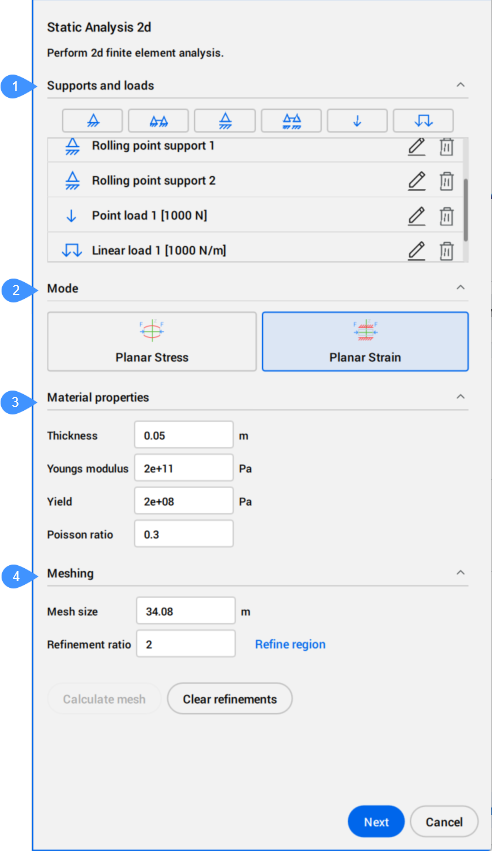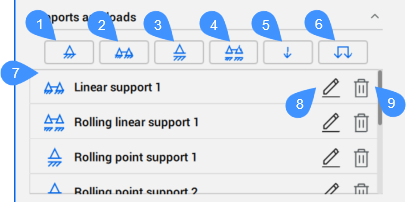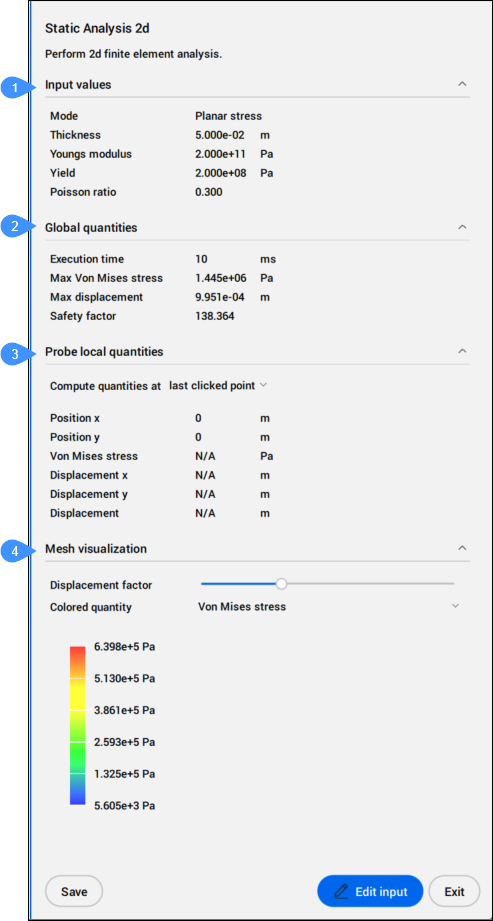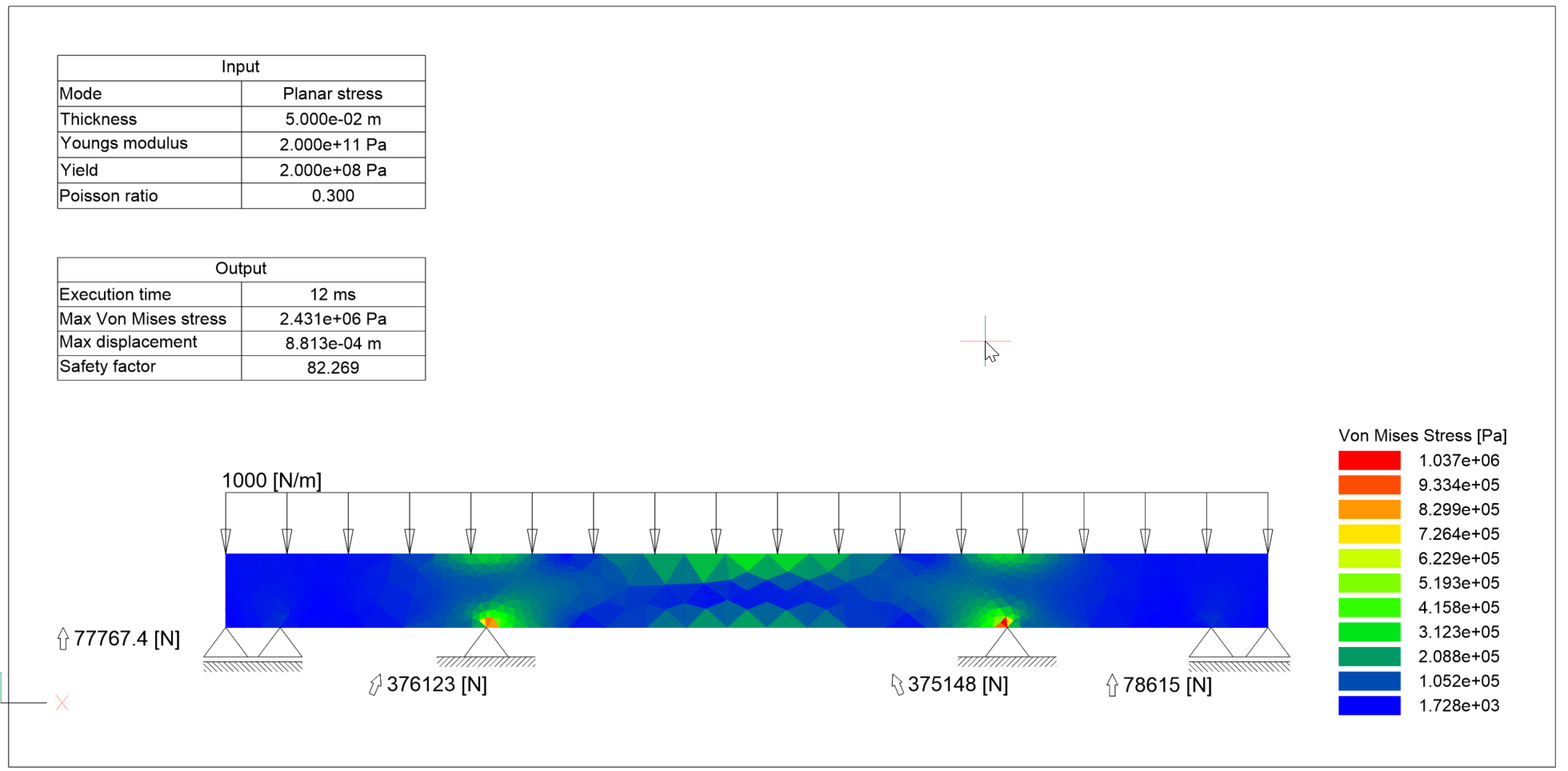CAEANALYZE2D command
Runs a 2D Finite Element Analysis.

Icon: 
Description
Runs a 2D Finite Element Analysis for a closed 2D boundary or 3D planar face that must be in the XY plane of the World Coordinate System.
Method
First, select a closed 2D boundary, a 3D planar face, a region, or a closed curve in the XY plane. After that, in the Static Analysis 2D command context panel, you can define the material and physical parameters, loads and supports, as well as a mesh for the input boundary. Then, run the analysis, visually inspect it, and interact with the analysis result.
The material and physical parameters include Young's modulus, the Poisson ratio, the yield, and the thickness. Loads include point forces and linear pressures, and supports include point and linear supports. The analysis results contain a summary of the input values, some global output values (execution time, maximum Von Mises stress, maximum displacement, and a safety factor), and a colored mesh visualization of the displacement or the Von Mises stresses.

- Supports and loads
- Mode
- Material properties
- Meshing
Supports and loads
Adds the loads (point forces and linear pressures) and supports (point and linear supports, rolling point and rolling linear supports) by clicking the corresponding button. Loads and supports can be placed over curved entities.

- Add point support
- Add linear support
- Add rolling point support
- Add rolling linear support
- Add point load
- Add linear load
- List of added supports and loads
- Edit button
- Remove button
- Add point support
- Adds a point support by clicking the point location on the boundary of the region in the drawing.
- Add linear support
- Adds a linear support by clicking the first and second point locations on the boundary of the region in the drawing.
- Add rolling point support
- Adds a rolling point support by clicking the point location on the boundary of the region in the drawing.
- Add rolling linear support
- Adds a rolling linear support by clicking the first and second point locations on the boundary of the region in the drawing.
- Add point load
- Adds a point load by clicking the point location on the boundary of the region in the drawing. Then, specify the angle of the load to the tangent of the boundary (90 degrees by default, for example, perpendicular to the boundary) and specify the point load magnitude.
- Add linear load
- Adds a linear load by clicking the first and second point locations on the boundary of the region in the drawing. Then, you have to specify the angle of the linear pressure to the tangent of the boundary (90 degrees by default, for example, perpendicular to the boundary) and to specify the linear pressure magnitude.
Graphic representation of the supports and loads in the drawing

- Each type of support and load have a graphic representation (symbol) in the drawing.
- The annotation scale determines the size of the supports and loads symbols in the Model Space.
- The supports and loads graphic representation is kept in the drawing after the command is finished, so that it can be reused later.
- List of added supports and loads
- Lists all added supports and loads. Each of them can be edited or removed.Note: When adding or editing the supports or loads, the command context panel closes, and the options are available in the Command line.
Options within the Command line when adding or editing supports or loads
- Loads
- Manages the loads.
- Add load
- Adds a load.
- Point load
- Adds a point load by specifying the point location, the angle of the load and the point load magnitude.
- Specify point location
- Allows you to pick a point for load location.
- Specify the angle of the load, tangent to the boundary
- Allows you to specify the tangent angle to the boundary or accept the default value.
- Specify the point load magnitude
- Allows you to specify the point load magnitude.
- Linear load
- Adds a linear pressure.
- Specify first point location
- Allows you to pick the first point for linear pressure location.
- Specify second point location or change direction
- Allows you to pick the second point for linear pressure location. You can also first set the direction in which the second point is located.
- Automatic
- Automatically detects the direction for the second point.
- COUnterclockwise
- Allows you to pick the second point in a counterclockwise direction.
- CLOCkwise
- Allows you to pick the second point in a clockwise direction.
- Close
- Closes the position point selection.
Use the Hotkey Assistant widget to change the direction of the second point. Press the Ctrl key to switch between the displayed options.
 Note: The Hotkey Assistant widget is displayed if the HOTKEYASSISTANT system variable is set to 1 (see Hotkey Assistant widget article).
Note: The Hotkey Assistant widget is displayed if the HOTKEYASSISTANT system variable is set to 1 (see Hotkey Assistant widget article).
- Specify the angle of the linear pressure tangent to the boundary
- Allows you to set the angle of the linear pressure.
- Absolute angle wrt. x-axis
- Allows you to set the angle of the linear pressure relative to the x-axis.
- Specify the linear pressure magnitude
- Allows you to specify the linear pressure magnitude.
- Remove load
- Removes the selected load.
- Edit load
- Allows you to change the position, angle and magnitude of the selected load.
- Position
- Allows you to set the new position of load.
- Angle
- Allows you to set the new angle of the load.
- Magnitude
- Allows you to set the new value for the magnitude of the load.
Note: The options are the same as for Add load.
- Supports
- Manages the supports.
- Add support
- Adds a support
- Point support
- Adds a point support by specifying the point location and the angle of the support.
- Specify point location
- Allows you to pick a point for support location.
- Specify the angle of the support, tangent to the boundary
- Allows you to specify the tangent angle to the boundary or accept the default value.
- rollinG Point support
- Adds a rolling point support by specifying the point location and the angle for the support.
- Linear support
- Adds a linear support.
- Specify first point location
- Allows you to pick the first point for linear support location.
- Specify second point location or change direction
- Allows you to pick the second point for linear support location. You can also first set the direction in which the second point is located.
- rollinG Linear support
- Adds a rolling linear support by specifying the first and second point locations.
- Edit button
- Allows you to edit the load or support.
- Remove button
- Allows you to remove the load or support.
Mode
Allows you to choose which mode to run the analysis.
- Planar stress
- Runs the analysis in planar stress mode. This mode should be used when the stress tensor is assumed to not have out of plane components.
- Planar strain
- Runs the analysis in planar strain mode. This mode should be used when the strain in the Z-direction is assumed to be zero.
Material properties
Defines the material properties.
- Thickness
- Defines the thickness of the material.
- Youngs modulus
- Defines the Young modulus of the material.
- Yield
- Defines the Yield of the material.
- Poisson ratio
- Defines the Poisson ratio.
Meshing
Defines a mesh for the input boundary.
- Mesh size
- Defines the desired edge length of mesh elements.
- Refinement ratio
- Sets a refinement ration used for refine region.
- Calculate mesh
- Generates the mesh for the entire region according to the mesh size, loads, and constraints.Note: This button is only available when you generate the mesh for the first time.

- Update mesh
- Updates the mesh after changing the mesh size, loads, or supports.
- Refine region
- Allows you to add multiple refined regions, improving the generated mesh based on specified refinement ratios.

- Clear refinements
- Removes all refine regions.
By pressing the Next button, the result of analysis opens.
Result of analysis

- Input values
- Global quantities
- Probe local quantities
- Mesh visualization
- Input values
- Displays the input values defined in the previous panel.
- Global quantities
- Displays the calculated output values.
- Probe local quantities
- Displays the local output values on a specified point. Choose one option from the drop down list, last clicked point or hovered point.
- Position x
- Displays the X position of the point.
- Position y
- Displays the Y position of the point.
- Von Mises stress
- Displays the Von Mises stress in the point.
- Mesh visualization
- Controls the visualization of the results on the mesh.
- Save
- Places the analysis results in the Model Space.

- Edit input
- Opens the previous page to edit the characteristics required for 2D analysis.


